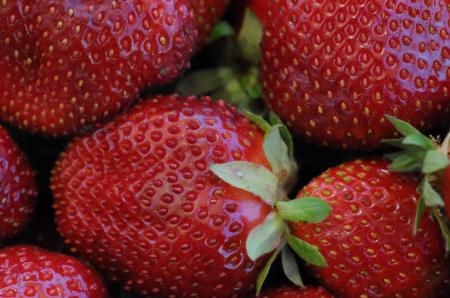UC Blogs
They'll Light Up Your Life
Most scorpions glow under an ultraviolet light, but now a discovery on Alcatraz Island reveals that a certain species of millipedes will,...
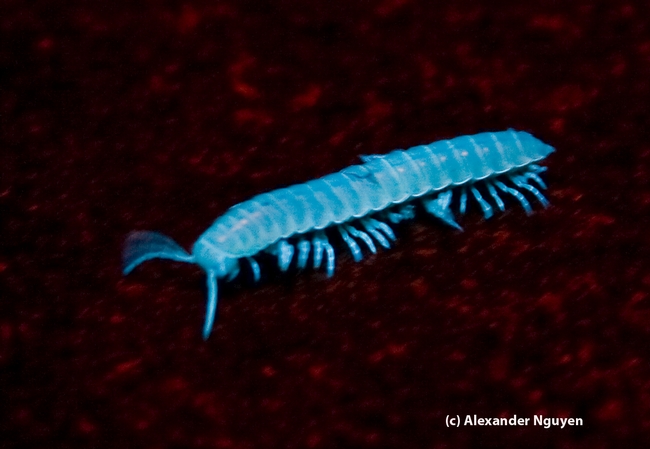
This millipede (Xystocheir dissecta) glows under ultraviolet light. Alexander Nguyen of the UC Davis Entomology Club captured this image on Alcatraz, during one of UC Davis forensic entomologist Robert Kimsey's field trips.
Central Coast community celebrates strawberries
Arroyo Grande recently hosted its annual Strawberry Festival, said an article in the Santa Maria Times. And this year, the city has more than ever to celebrate. In 2011, strawberries took the top spot in terms of production value in the San Luis Obispo Agriculture Commissoner's crop report.
The county’s strawberries were valued at more than $179 million in 2011.
Surendra Dara, UC Cooperative Extension advisor in San Luis Obispo County, a strawberry expert, said the 2012 crop is still larger and doing very well.
“In the fields I’ve been checking, they’re very tasty,” Dara said.
The factor that has the greatest impact on strawberry sweetness and flavor, he said, is variety. The most popular variety is the Albion, which was developed by the University of California. The UC-developed San Andreas variety is also popular.
Thinning Peaches
We have two peach trees (Prunus persica) in our backyard. The old tree, original to the property, is a delicious cling (the flesh adheres to the pit). We are not sure what type of peach it is, but it is still producing fruit. Since the harvest is usually small, we eat these as fast as they ripen. Well, okay, we do share a few of them with family and neighbors. The newer tree is a ‘Red Haven’, which is a freestone (the flesh separates from the pit). Last year my husband grafted an ‘Elberta’ peach onto a branch of this tree and it has fruit for the first time. The newer tree is 13 years old and was one of the first fruit trees we planted in 1999. We have always had a bumper crop of fruit on this tree and our friends, family and neighbors know when it is ‘peach picking time’ at our house. The peaches are firm, sweet and delicious, and ripen early in the season. In years past, we have made peach pies, peach jam, peach syrup ice cream topping, peaches and cream dessert bars, (you get the picture). To get these wonderful peaches, both trees are pruned and fertilized once a year, sprayed twice a year with dormant spray and thinned heavily each year. Most peach trees require 600 to 900 hours of winter chill. Annual pruning renews fruiting wood and encourages fruiting throughout the tree rather than at the ends of weak branches that would break. My husband is very particular about thinning. His goal is to have large, beautiful fruit. It is not unusual for him to fill his wheelbarrow half way full of one inch wide peaches when he is thinning. His motto is to thin 8 to 10 inches apart and he sticks to this method. This dedication pays off with magnificent peaches.
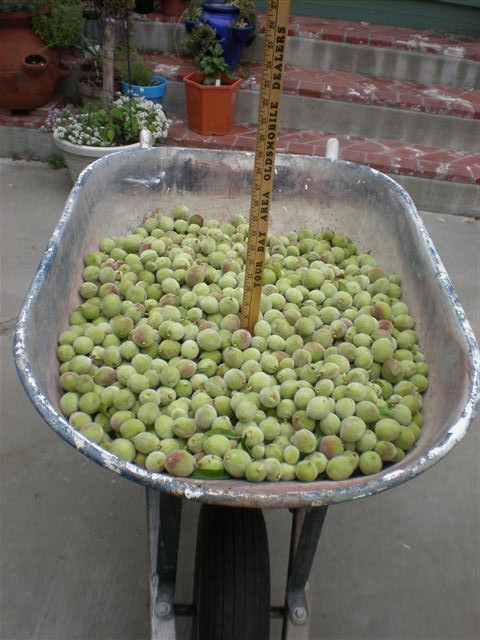
Wheelbarrow full of thinned peaches. (photos by Sharon Rico)
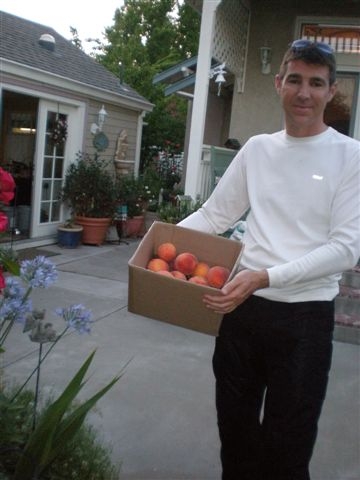
My son Joel with our peaches.
And Now, Your California State Insect...
There's always something special going on at the Bohart Museum of Entomology on the UC Davis campus. But this Sunday, June 3, something even more...
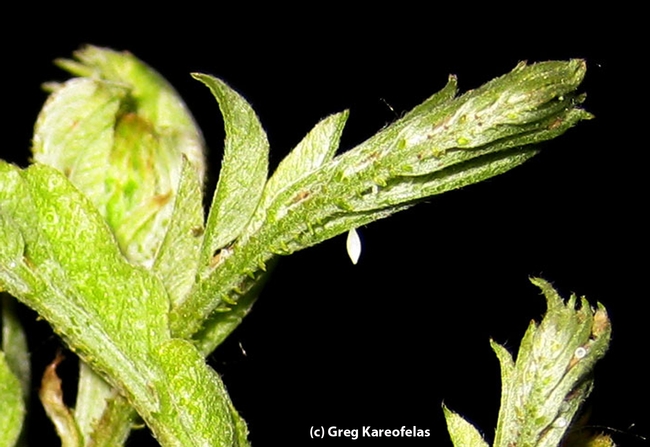
Egg of a California dogface butterfly. (Photo by Greg Kareofelas)
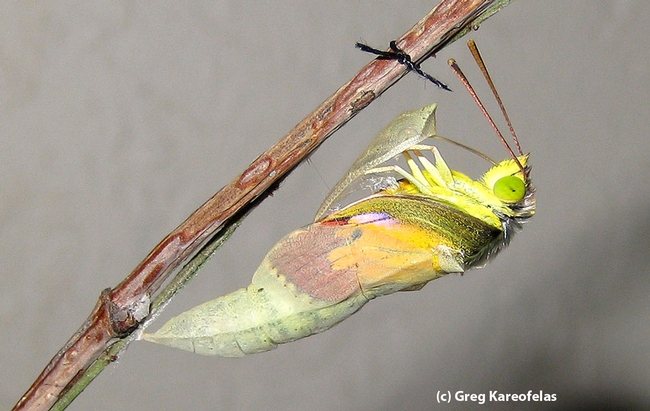
California dogface butterfly emerging from chrysalis. (Photo by Greg Kareofelas)
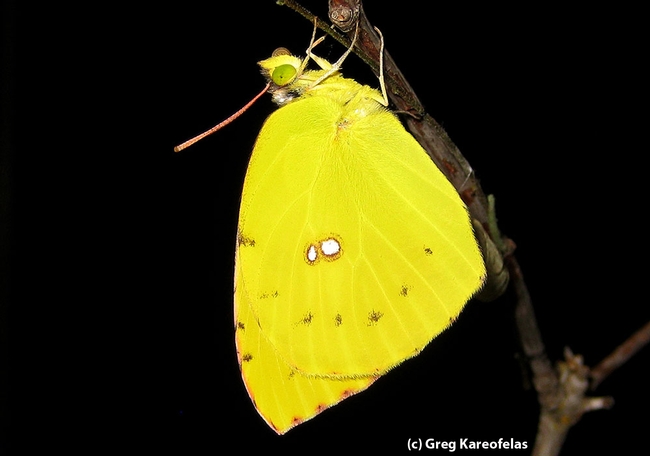
Newly emerged California dogface butterfly. (Photo by Greg Kareofelas)
The Summer Buzz
After a couple of lackluster years in my vegetable garden I have high hopes for this summer’s effort. For the first time in far too long, bees are working busily in my garden.
The combination of cooler than usual summers the past two years, along with a dwindling bee population has made its mark in my back yard. Tomatoes, zucchini, cantaloupe and beans that grew effortlessly have required hand pollination which has been only marginally successful. Even with that extra effort, the relatively cool temperatures of the past two summers have not spurred the tomatoes into their usual fruiting frenzy.
The bees made themselves known in March when the ceanothus began to bloom. We could hear the frenetic buzzing from inside the house. By the time the ceanothus quieted down, bees were busy in the potato vine and beginning to visit the bright yellow blooms on the tomato plants. I’m hopeful pollination will proceed accordingly
As for the hot summer, it’s more of a double-edged sword. Those cooler summers may not have encouraged vegetables but they sure made the season easier to enjoy. I know we can’t have both, and now while it’s cool, tomatoes have the edge over 100 degree days. You have to be careful what you wish for though, and the outcome probably depends on whether I begin to delight in the vegetables before the heat hits us.

Bee on lavender. (photo by Tom Burton)


